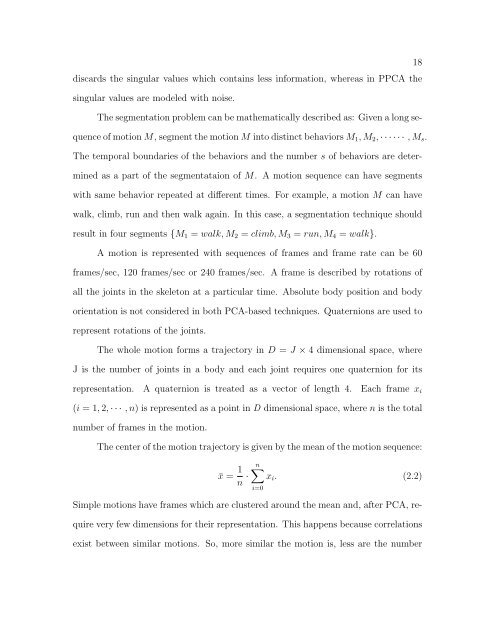A COMPARISON AND EVALUATION OF MOTION INDEXING ...
A COMPARISON AND EVALUATION OF MOTION INDEXING ...
A COMPARISON AND EVALUATION OF MOTION INDEXING ...
You also want an ePaper? Increase the reach of your titles
YUMPU automatically turns print PDFs into web optimized ePapers that Google loves.
discards the singular values which contains less information, whereas in PPCA the<br />
singular values are modeled with noise.<br />
The segmentation problem can be mathematically described as: Given a long se-<br />
quence of motion M, segment the motion M into distinct behaviors M1, M2, · · · · · · , Ms.<br />
The temporal boundaries of the behaviors and the number s of behaviors are deter-<br />
mined as a part of the segmentataion of M. A motion sequence can have segments<br />
with same behavior repeated at different times. For example, a motion M can have<br />
walk, climb, run and then walk again. In this case, a segmentation technique should<br />
result in four segments {M1 = walk, M2 = climb, M3 = run, M4 = walk}.<br />
A motion is represented with sequences of frames and frame rate can be 60<br />
frames/sec, 120 frames/sec or 240 frames/sec. A frame is described by rotations of<br />
all the joints in the skeleton at a particular time. Absolute body position and body<br />
orientation is not considered in both PCA-based techniques. Quaternions are used to<br />
represent rotations of the joints.<br />
The whole motion forms a trajectory in D = J × 4 dimensional space, where<br />
J is the number of joints in a body and each joint requires one quaternion for its<br />
representation. A quaternion is treated as a vector of length 4. Each frame xi<br />
(i = 1, 2, · · · , n) is represented as a point in D dimensional space, where n is the total<br />
number of frames in the motion.<br />
The center of the motion trajectory is given by the mean of the motion sequence:<br />
¯x = 1<br />
n ·<br />
18<br />
n<br />
xi. (2.2)<br />
Simple motions have frames which are clustered around the mean and, after PCA, re-<br />
quire very few dimensions for their representation. This happens because correlations<br />
exist between similar motions. So, more similar the motion is, less are the number<br />
i=0
















